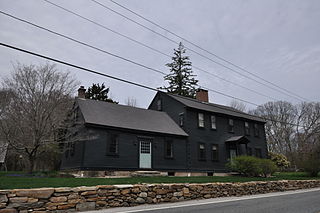
The Mount Vernon Tavern, also known as the Bank House Tavern, is an historic house in Foster, Rhode Island. It is located at 199 Plainfield Pike, about 3/10 of a mile east of its junction with Howard Hill Road. The main block of the house, a 2-1/2 story wood frame structure with gable roof, was built c. 1760, and was originally attached to an even older structure which was demolished in the late 19th century. This main block, five bays wide with a central chimney, is attached to a 1-1/2 story gable-roofed ell to the west. The main entrance portico features unusually elaborate Federal styling for a rural location, and was probably added in 1814. The house has long been a landmark on the road, serving as a stagecoach stop on what was the main road between Providence and points in Connecticut.

The C. Burton Hotel, also known as the Sycamore House, is located on NY 55 a mile west of Grahamsville, New York, United States. It is a wooden Greek Revival structure dating to 1851.

The Landmark Inn State Historic Site is a historic inn in Castroville, Texas, United States. It serves the general public as both a state historic site and a bed & breakfast with eight overnight rooms.

The historic building now operated as the restaurant Jakes Chaparral had a number of prior uses including Kanab Lodge, Parry Cafeteria, Utah Parks Building and Wok Inn restaurant in Kanab, Utah. The original section of the lodge is a house built in 1885, which was expanded between 1928 and 1932 by the Utah Parks Company to serve as a rest stop for tourists about halfway between the north rim of the Grand Canyon and Zion or Bryce Canyon National Parks.

The Dorrance Inn, also known as the Samuel Dorrance House, is a historic former inn at 748 Plainfield Pike in Sterling, Connecticut. Built about 1722, it is notable as a place that hosted officers of the French Army in 1781 and 1782, as it was along the march route taken by French commander Rochambeau's troops en route to Yorktown, Virginia. Dorrance's Inn is one of a few places mentioned by name in multiple accounts written by French officers. The building was individually listed on the National Register of Historic Places in 2002. and is a contributing building in the Sterling Hill Historic District.
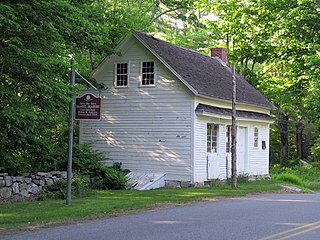
The Gurdon Bill Store is located in Ledyard, Connecticut. In 1818, the land for the store was purchased by Gurdon Bill and his partner, Philip Gray. In 1819, Gray sold his interest in the store for $500. Bill operated the store until his death in 1856 and the store is believed to have made its final transaction in 1868. It has not been used since it was sold to the Congregational Society in 1875, retaining its historical integrity. The store is an 18-by-30-foot by 1 1⁄2-story gable-roofed clapboarded structure built upon fieldstone and stone blocks. It has some unusual architecture in the form of a pent-roof and three-part window shutters. Clouette describes the store as "the best preserved early 19th-century store known in Connecticut." The Gurdon Bill Store was added to the National Register of Historic Places on April 12, 1982.

The Walker Tavern is a historic structure located at 11710 U.S. Route 12 in Cambridge Township in northwesternmost Lenawee County, Michigan. It was designated as a Michigan Historic Site on February 19, 1958 and was later the county's first property added to the National Register of Historic Places on January 25, 1971. The structure was incorporated into the Cambridge Junction Historic State Park and continues to serve as a museum and venue for various events.
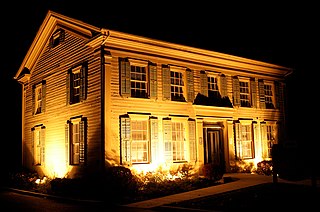
The Flanders House is a historic residence in Plainfield, Illinois.

The former Smith Tavern is located on Bedford Road in the hamlet of Armonk, New York, United States. It is a red frame building dating to the late 18th century, one of the few left in a region that has rapidly suburbanized over the past century. The Smith family, for whom it is named, did not build it but owned it for most of the 19th century.

The Piety Hill Historic District is a historic district located in downtown Lapeer in Lapeer County, Michigan. It was designated as a Michigan State Historic Site and also added to the National Register of Historic Places on July 26, 1985.

Brooks–Brown House, also known as the Brown-Law House, Law Home, and Halfway House, is a historic home located near Dickinson, Franklin County, Virginia. The first section was built about 1830, with a two-story addition built about 1850. Renovations about 1870, unified the two sections as a two-story, frame dwelling with a slate gable roof. At the same time, an Italianate style two-story porch was added and the interior was remodeled in the Greek Revival style. A rear kitchen and bathroom wing was added as part of a renovation in 1987-1988. It measures approximately 52 feet by 38 feet and sits on a brick foundation. Also on the property are a contributing detached log kitchen and dining room, a cemetery, and the site of a 19th-century barn. The house served as a stagecoach stop and inn during the mid-19th century and the property had a tobacco factory from about 1870 until 1885.

The Deery Inn, also known as "The Old Tavern" or "The Mansion House and Store," is a historic building on Main Street in Blountville, Tennessee. It is listed on the National Register of Historic Places and is considered the "centerpiece" of the Blountville local historic district.

Aue Stagecoach Inn is a complex of three structures built by German immigrant Max Aue and is located on Boerne Stage Rd. and I-10, in Leon Springs, county of Bexar, in the U.S. state of Texas. It was added to the National Register of Historic Places in 1979, and is an example of 19th century vernacular architecture of Texas.

The Wakefield House is a historic house on New Hampshire Route 153 in the Wakefield Corner area of Wakefield, New Hampshire. The 2-1/2 story wood frame house is believed to have been built c. 1785, but its exterior styling is mainly Federal in character, dating to the 1820s or later. It was used as an inn on the busy stagecoach route through town in the 19th century. It was listed on the National Register of Historic Places in 1983.

Squaw Peak Inn is a historic structure located at 4425 E. Horseshoe Road in the east end of Piestewa Peak Mountain, formerly known as Squaw Peak Mountain. The inn, which has served as the lodging for various celebrities, was listed in the National Register of Historic Places on January 1, 1995.

The Moorehead Stagecoach Inn is a historic building located in Ida Grove, Iowa, United States. The Western Stage Line began to operate stagecoaches from Lizzard Point to Sergeant Bluff in 1855. The following year John H. Moorehead began building this inn. It was completed in 1863, and it was the first building constructed in Ida Grove. It is a 1½-story, L-shaped, frame structure with twelve rooms. The building served a variety of purposes in its early days. Two years after Ida County was organized it became the county courthouse and remained so until 1871. The building also housed the post office, as well as religious, educational, and commercial purposes.

The Stagecoach Inn is a historic building at the corner of United States Route 7 and Fern Lake Road in the center of Leicester, Vermont. Built about 1830, it is one of the best-preserved examples of a 19th-century stagecoach accommodation between Rutland and Vergennes, with a distinctive combination of Federal and Greek Revival architectural elements. Now converted to a residence, it was listed on the National Register of Historic Places in 1984.
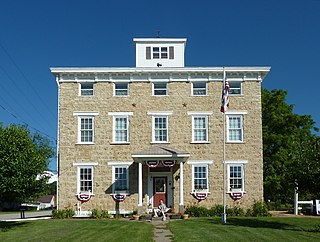
The Sherrill Mount House, also known as the Fries Hotel, Moundside Apartments, and The Inn at Sherrill, is a historic building located in Sherrill, Iowa, United States. This is one of the few surviving pre-Civil War hotels left in Iowa, and one of the largest early stone structures remaining in rural Dubuque County. The three-story building is composed of native limestone with a cupola on top of the hip roof. It was built along a stagecoach route that traveled along the Mississippi River. At one time it was situated on a 40-acre (16 ha) plot of land on which were several out buildings for an agricultural operation that included an orchard and vineyard. The building also served the community as a post office and meeting hall. Before national prohibition in 1919 the inn included a beer garden, tavern and dance hall. It was at this time that the building was converted into an apartment building. It has subsequently been converted into a bed and breakfast called the Black Horse Inn. The house was listed on the National Register of Historic Places in 2002.
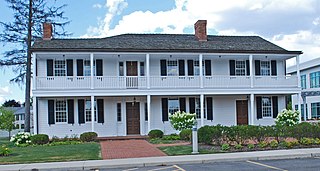
The Botsford Inn is a nineteenth century inn and tavern located at 28000 Grand River Avenue in Farmington, Michigan. It was listed on the National Register of Historic Places in 1979.

The Hegel Road Historic District is a mixed commercial and residential historic district located along Hegel Road between Seneca and the Goodrich Millpond in Goodrich, Michigan. It was listed on the National Register of Historic Places in 1982.

























